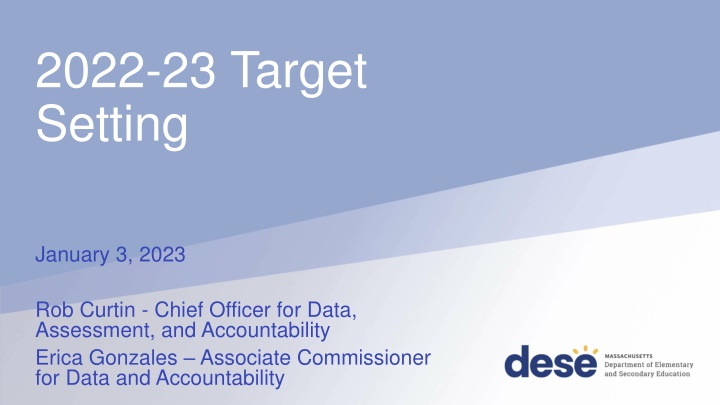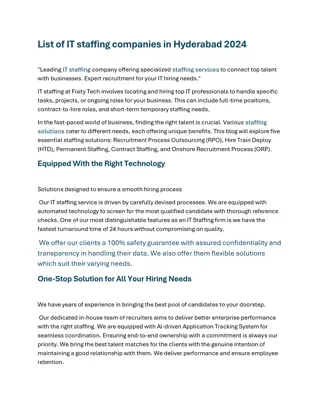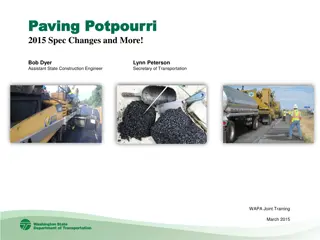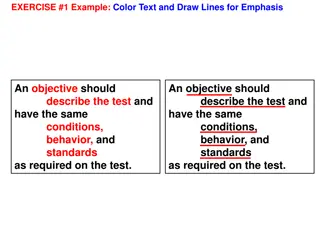
State-Level Goals and Targets for Student Achievement
Explore the establishment of ambitious long-term goals and measurements of progress for all students under the Every Student Succeeds Act (ESSA) and Student Opportunity Act (SOA). Dive into the challenges and variances in achievement losses to address disparities in student groups effectively.
Uploaded on | 3 Views
Download Presentation

Please find below an Image/Link to download the presentation.
The content on the website is provided AS IS for your information and personal use only. It may not be sold, licensed, or shared on other websites without obtaining consent from the author. If you encounter any issues during the download, it is possible that the publisher has removed the file from their server.
You are allowed to download the files provided on this website for personal or commercial use, subject to the condition that they are used lawfully. All files are the property of their respective owners.
The content on the website is provided AS IS for your information and personal use only. It may not be sold, licensed, or shared on other websites without obtaining consent from the author.
E N D
Presentation Transcript
2022-23 Target Setting January 3, 2023 Rob Curtin - Chief Officer for Data, Assessment, and Accountability Erica Gonzales Associate Commissioner for Data and Accountability 1
Every Student Succeeds Act (ESSA) Establish state-level ambitious long-term goals and measurements of interim progress for all students and for each student group in the areas of: Academic achievement Graduation rates Progress toward English language proficiency For state achievement and graduation rate targets: The length of time given to reach each goal is the same for all students and for each student group For groups that are behind, targets should consider the improvement needed to close gaps Targets for schools must be based on the long-term goals established for the state 2
Student Opportunity Act (SOA) The Commissioner mush establish statewide targets for addressing persistent disparities in achievement among student groups: For all students and for each student group Including, but not limited to, subject matter and relevant grade levels Including annual benchmarks for all students and for each student group Each district must establish targets for addressing persistent disparities in achievement among student groups consistent with the targets established by DESE Metrics used to measure success must be included in district s 3-year plans 3
Student Opportunity Act (SOA) DESE will develop standard metrics that may be incorporated in district plans and may include: MCAS results, including student growth ACCESS results Grade-level completion and attendance data Participation in advanced coursework; and Other indicators of district and school climate, diversity and performance 4
Challenge wide variance in achievement losses Change in ELA Scaled Score - 2019 to 2022 - School 25th 33rd 67th 75th Median N Percentile Percentile Mean Percentile Percentile Non-HS 1,339 -10.0 -9.0 -7.3 -7.3 -5.5 -4.5 HS 340 -6.8 -5.8 -4.2 -4.0 -2.1 -1.4 5
Challenge not all schools lost ground ELA Scaled Score Math Scaled Score Science Scaled Score Count where change>0 Count where change>0 Count where change>0 N N N Non-HS 1,339 48 1,339 142 1,071 234 HS 340 57 341 49 6
A Path to Recovery Each district/school/student group will have a full recovery target reflecting their 2019 scaled scores. The amount of the decline between 2019 and 2022 will determine the group's "time to recovery" quartile. Groups in the bottom quartiles (largest declines) will have a longer timeline to reach recovery than those with smaller declines in assessment scores. Annual targets will be calculated by dividing the difference between full recovery and 2022 scores by the number of years to reach full recovery as determined by the quartile in which each group falls. 7
A Path to Recovery ELA Non-HS Example 75th percentile = -4.5 SSP Median = -7.3 SSP 25th percentile = -10.0 SSP Time to recovery = 2 years Time to recovery = 4 years Time to recovery = 3 years Time to recovery = 1 year Districts, schools and student groups with the largest declines in MCAS scores will have the longest time for recovery but will still need demonstrate steady growth towards targets. 8
A Path to Recovery ELA Non-HS Example Annual expected improvement is comparable, even though the schools have different "time to recovery" quartiles. 2023 2019 2022 Full Recovery Target Years to Recovery School Change Quartile Achievement Target Achievement Achievement School X 492 483 - 9 492 3 3 486 School Y 487 485 - 2 487 1 1 487 9
A Path to Move Forward All districts, schools, and student groups are starting from different places in relation to 2019 400 districts, 1,500 schools, 10 student groups, 3 subjects Most schools/groups have a mix of ahead and behind where they were in 2019 Need a parallel system for a path forward Once a school/subject/group recovers it moves to the path forward and receives targets beyond their full recovery point focused on closing achievement gaps Schools would be on two paths at once in order to have continuous improvement expectations for everyone 10




















